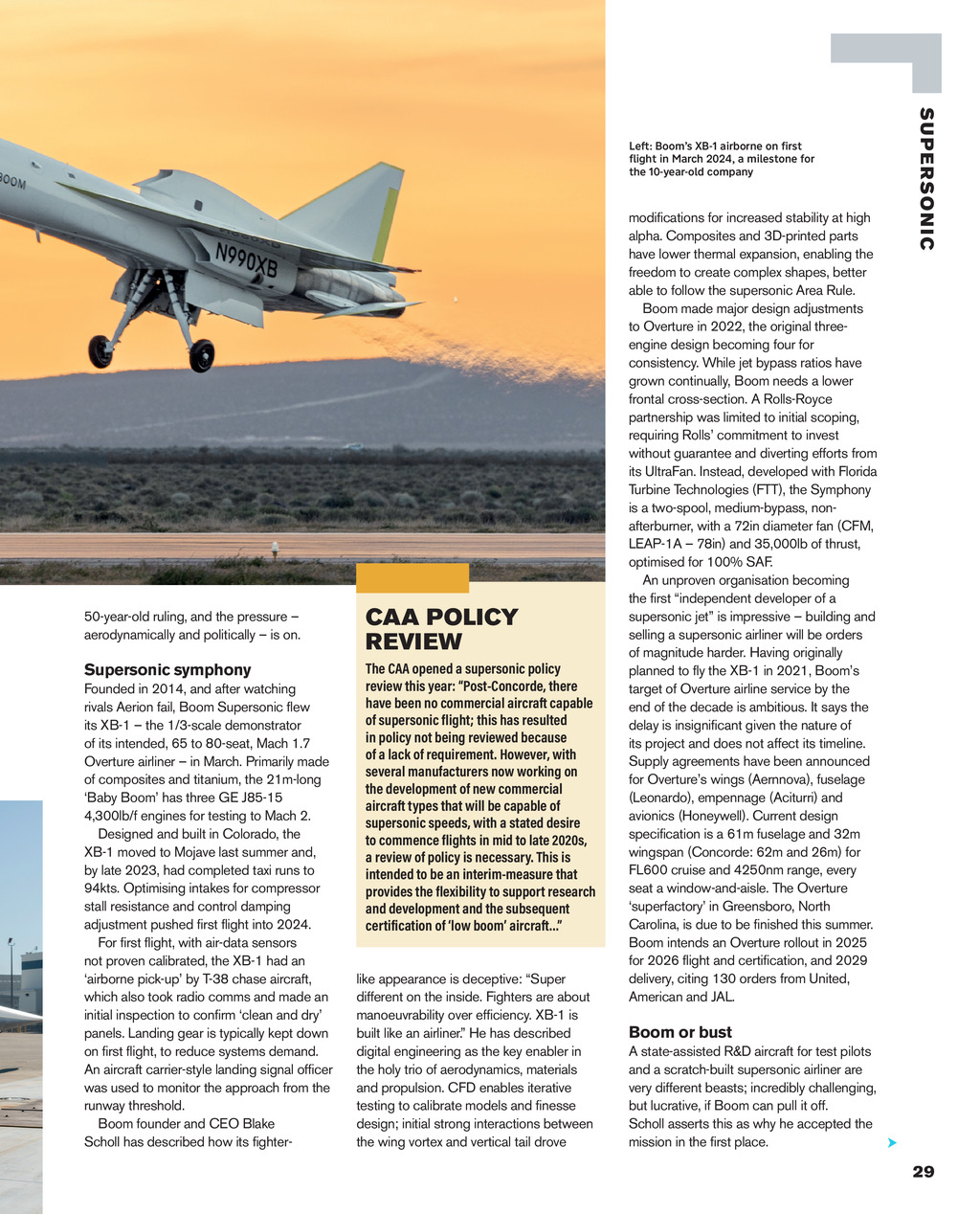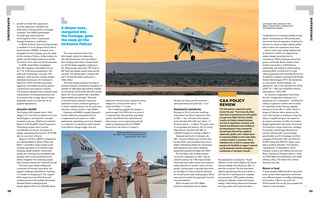




S U P E R SO N I C aircraft to modify their supersonic acoustic signature is decades old, initial ideas involving chines or fuselage cutaways. Two NASA partnerships, 20 years ago, tested discrete technologies for boom suppression through shockwave modification. In 2003, Northrop Grumman flight-tested a modified F-5 for its Shaped Sonic Boom Demonstration (SSBD). A deeper nose, elongated into the fuselage, gave the sleek jet the nickname Pelican. Unlike bullets, the greater aircraft length produces a double boo-boom from nose and tail shockwaves. In 2006, Quiet Spike investigated this with a tapered, extendable nose on an F-15. A 6ft fairing supported a 14ft spike with a telescopic, two-part, 10ft extension, each junction creating weaker, individual shockwaves. An envelope of Mach 0.5-1.8/FL150-450 was tested against an unmodified aircraft by ground measurement and subsonic chasers. The acoustic signature had a reduced initial overpressure, increasing shockwave rise time; booms had a longer lag to a lesser amplitude, known as a flat top for its graphed appearance. Acoustic stealth The X-planes (66 designs since 1946, Yeagers X-1 the first) are platforms for new technologies or aerodynamic concepts. Unveiled in January, NASA and Lockheed Martins X-59 QueSST (Quiet Supersonic Technology) project aims to prove recertification by sound, not speed, its design suppressing the boom to 75 PLdB, akin to a car doors thump. Begun in 2018 in a $247m programme at Lockheed Martins Skunk Works, the Mach 1.4 aircrafts unique shape is the acoustic equivalent of its faceted, radarcheating, stealth brethren. Downward shocks are minimised by smoothed lower surfaces with minimal protrusions and others mitigated: the underlying engine deck ensures shocks dont blend at the tail. The build used robotic drilling and composite UV-bonded wing skins, the biggest challenge described as building it in tandem to designing it. The original F404 engine from the F/A-18 proved underpowered for the profiles demanded, General Electric redesigning the Gripen fighters F414 for 22,000lb thrust. A deeper nose, elongated into the fuselage, gave the sleek jet the nickname Pelican The nose is almost a third of its 30m length, critical for dispersing the initial shockwave and preventing it from merging with others. Viewed headon, the flat blade suggests a platypuss bill. Wing sweep varies from 76 (root) to 69 (tip) with sharply swept nose and tail canards. The landing gear is shared with the F-16 and anti-static paint gives a Teflon effect. The purist design prevents the drag of forward windows, avoiding the headache of visibility on high-alpha approaches. Instead, a commercial, off-the-shelf ultra-HD camera above the nose is paired with a standard, flight-certified one beneath. Removal of forward-facing windows may prove opportune in future, a beacon guiding us to where visibility barriers can be overcome with this inventive solution, says NASA. Engineers at NASAs Langley Research Center trialled the anticipated thud of a suppressed sonic boom on civilian participants, separating sound and vibration in a chamber to understand which causes most offence. Design length, size and speed are critical to boom signature, hence designs for a future airliner favour ~70 seats and Mach 1.7 cruise. This modelling suggests the design is quiet enough; the X-59s job is to prove it in national trials. Ground data and public opinion submitted to the authorities will help answer: can re-engineering aircraft justify re-engineering the law? NASA knows this is its chance to repeal a NASA test pilots Nils Larson (l) and Jim Clue Less (r) with Lockheed Martin test pilot Dan Dog Canin 28 THE LOG Sum 24 pp26-31 Supersonic.indd 28 13/06/2024 12:43